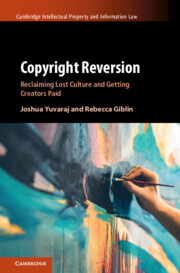
-
Select format
-
- Publisher:
- Cambridge University Press
- Publication date:
- 19 September 2025
- 09 October 2025
- ISBN:
- 9781009334839
- 9781009334822
- Creative Commons:
-
This content is Open Access and distributed under the terms of the Creative Commons Attribution licence CC-BY-NC 4.0.
https://creativecommons.org/creativelicenses - Dimensions:
- (229 x 152 mm)
- Weight & Pages:
- 0.43kg, 210 Pages
- Dimensions:
- Weight & Pages:
Open AccessYou have digital access to this book
Book description
Copyright is meant to promote access to knowledge and culture and reward creators. But around the world, publishers, record labels and other investors continue to hoover up the rights and rewards due to creators and leave masses of creativity locked away from the public. This book shows why this bargain is broken, and how reverting copyright to creators can help redress it – allowing them to revitalise old works, turbocharged by technological advances that are providing more opportunities to do so than ever before. With cutting-edge empirical and doctrinal analysis of dominant reversion models from the United States, the Commonwealth and the EU, the book provides policymakers and academics with best-practice principles for designing reversion mechanisms that can help copyright laws do a better job of supporting the public interest in access while helping artists get paid. This title is also available as open access on Cambridge Core.
Contents
Full book PDF-
Copyright Reversion
pp i-i -
-
- You have access
- Open access
- HTML
- Export citation
-
-
Cambridge Intellectual Property and Information Law - Series page
pp ii-ii -
-
- You have access
- Open access
- HTML
- Export citation
-
-
Copyright Reversion - Title page
pp iii-iii - Reclaiming Lost Culture and Getting Creators Paid
-
-
- You have access
- Open access
- HTML
- Export citation
-
-
Copyright page
pp iv-iv -
-
- You have access
- Open access
- HTML
- Export citation
-
-
Dedication
pp v-vi -
-
- You have access
- Open access
- HTML
- Export citation
-
-
Contents
pp vii-viii -
-
- You have access
- Open access
- HTML
- Export citation
-
-
Acknowledgements
pp ix-x -
-
- You have access
- Open access
- HTML
- Export citation
-
-
1 - Reversion’s Potential
pp 1-31 -
-
- You have access
- Open access
- HTML
- Export citation
-
-
2 - Statutory Reversion Rights in the British Commonwealth
pp 32-62 -
-
- You have access
- Open access
- HTML
- Export citation
-
-
3 - US Termination Rights
pp 63-89 -
-
- You have access
- Open access
- HTML
- Export citation
-
-
4 - Statutory Reversion Rights in Europe
pp 90-124 -
-
- You have access
- Open access
- HTML
- Export citation
-
-
5 - Contractual Reversion Rights
pp 125-148 -
-
- You have access
- Open access
- HTML
- Export citation
-
-
6 - Best-Practice Principles for Copyright Reversion Mechanisms
pp 149-174 -
-
- You have access
- Open access
- HTML
- Export citation
-
-
Index
pp 175-182 -
-
- You have access
- Open access
- HTML
- Export citation
-
-
Cambridge Intellectual Property and Information Law - Series page
pp 183-186 -
-
- You have access
- Open access
- HTML
- Export citation
-
Metrics
Altmetric attention score
Full text views
Full text views help Loading metrics...
Loading metrics...
* Views captured on Cambridge Core between #date#. This data will be updated every 24 hours.
Usage data cannot currently be displayed.
Accessibility standard: Missing or limited accessibility features
Why this information is here
This section outlines the accessibility features of this content - including support for screen readers, full keyboard navigation and high-contrast display options. This may not be relevant for you.
Accessibility Information
The PDF of this book is known to have missing or limited accessibility features. We may be reviewing its accessibility for future improvement, but final compliance is not yet assured and may be subject to legal exceptions. If you have any questions, please contact accessibility@cambridge.org.
Content Navigation
Table of contents navigation
Allows you to navigate directly to chapters, sections, or non‐text items through a linked table of contents, reducing the need for extensive scrolling.
Index navigation
Provides an interactive index, letting you go straight to where a term or subject appears in the text without manual searching.
Reading Order and Textual Equivalents
Single logical reading order
You will encounter all content (including footnotes, captions, etc.) in a clear, sequential flow, making it easier to follow with assistive tools like screen readers.
Short alternative textual descriptions
You get concise descriptions (for images, charts, or media clips), ensuring you do not miss crucial information when visual or audio elements are not accessible.
Full alternative textual descriptions
You get more than just short alt text: you have comprehensive text equivalents, transcripts, captions, or audio descriptions for substantial non‐text content, which is especially helpful for complex visuals or multimedia.
Visual Accessibility
Use of colour is not sole means of conveying information
You will still understand key ideas or prompts without relying solely on colour, which is especially helpful if you have colour vision deficiencies.
Use of high contrast between text and background colour
You benefit from high‐contrast text, which improves legibility if you have low vision or if you are reading in less‐than‐ideal lighting conditions.

